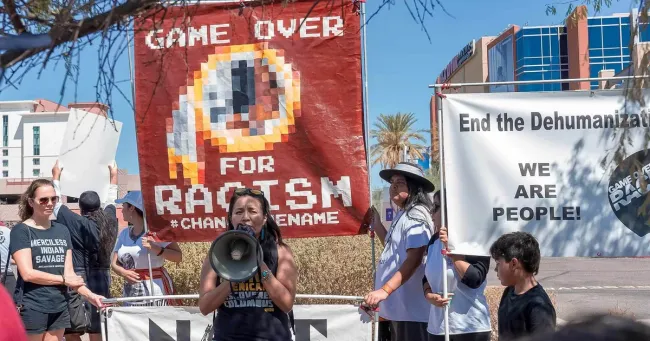The Kansas City Chiefs: A Legacy of Controversy and Cultural Reckoning
A Problematic Origin: The History of the "Chiefs" Name
The Kansas City Chiefs’ name traces back to Harold Roe Bartle, a white mayor nicknamed “Chief” for his role in founding the Boy Scouts’ Tribe of Mic-O-Say, a group that appropriated Native American rituals and imagery. Although Bartle claimed to have been inducted into the Arapaho tribe, the Mic-O-Say program—with its faux ceremonies and costumes—has been criticized as cultural cosplay. When the Dallas Texans relocated to Kansas City in 1963, the team rebranded as the “Chiefs” to honor Bartle, cementing a legacy disconnected from actual Indigenous heritage.
From the start, the franchise leaned into stereotypes: early logos depicted a red-skinned Native man in a headdress, while game-day traditions included a horse mascot named Warpaint, ridden by a man in faux regalia. These practices, though later modified, laid the groundwork for decades of controversy.
Native American Backlash: Stereotypes, Protests, and Psychological Harm
For decades, Indigenous activists have condemned the Chiefs’ imagery and fan rituals. Central to the criticism are the tomahawk chop—a chant and arm-swinging gesture mimicking weapon use—and the use of war drums, headdresses, and face paint. These acts reduce sacred cultural symbols to sports entertainment, perpetuating harmful stereotypes of Native Americans as “savages” or relics of the past.
Key Criticisms:
- Psychological Impact: Studies show such mascots harm Native youth, reinforcing feelings of marginalization and fostering discrimination among non-Native children.
- Cultural Appropriation: Headdresses, earned through honor in many Indigenous communities, are worn casually by fans, while mock war chants trivialize spiritual practices.
- Hypocrisy in “Honor”: The Chiefs claim to celebrate Native culture, yet activists like Rhonda LeValdo (Acoma Pueblo) argue this is a “PR stunt.” As she states, “There’s no honor in cosplaying our culture while ignoring our lived realities.”
Activist Efforts:
- The Not In Our Honor Coalition, founded in 2005, has organized protests at every Chiefs Super Bowl appearance since 2019, including billboards demanding “Change the Name and Stop the Chop!”
- In 2023, Indigenous groups highlighted the irony of the NFL’s “End Racism” campaign while the Chiefs retained their name and traditions.
The Team’s Response: Progress or Performative Change?
The Chiefs have taken steps to address criticism, albeit inconsistently:
- Banned Headdresses and Face Paint: In 2020, the team prohibited these items at Arrowhead Stadium, though enforcement remains spotty.
- Retired Warpaint: The horse mascot, once ridden by a headdress-wearing performer, was retired in 2021.
- American Indian Community Working Group: Formed in 2014, this advisory board has influenced ceremonial blessings and heritage month events. Critics, however, argue the group excludes local Indigenous organizations like the Kansas City Indian Center.
Despite these efforts, the core issues—the name, logo, and chop—remain. As activist Gaylene Crouser (Kansas City Indian Center) notes, “The sheer entitlement of people outside our community telling us they’re honoring us is infuriating.”
Intersection with Black Communities: Hypocrisy and Solidarity
The Chiefs’ relationship with Black communities is equally fraught. While the team has supported racial justice initiatives—such as helmet decals honoring Black victims of police violence and “End Racism” end zone messages—activists highlight contradictions.
Key Tensions:
- Economic Disparities: Arrowhead Stadium sits in one of Kansas City’s poorest areas, yet the team has done little to address systemic inequities nearby.
- Selective Allyship: The franchise’s embrace of Black Lives Matter rhetoric clashes with its refusal to address Native appropriation. As LeValdo asks, “How can you claim to fight racism while profiting from our stereotypes?”
- Political Divides: Black leaders like Rep. Emanuel Cleaver defend the “Chiefs” name as a term of respect, drawing parallels to African tribal leadership. Yet many Indigenous activists reject this analogy, arguing the term’s colonial roots.
The Road Ahead: Accountability or Stagnation?
The Chiefs’ cultural reckoning mirrors broader societal debates. While teams like the Washington Commanders and Cleveland Guardians have rebranded, Kansas City clings to tradition. The 2024 Super Bowl saw renewed protests in Las Vegas, with activists urging Taylor Swift—whose relationship with Travis Kelce brought global attention—to denounce the chop.
What’s Next?
- Pressure on Sponsors: Following the playbook that forced Washington’s name change, activists aim to target corporate partners.
- Youth-Led Movements: High schools and colleges have led the charge in retiring Native mascots, offering a blueprint for grassroots change.
- Legislative Action: With Deb Haaland (Interior Secretary) calling for an end to Native mascots, federal pressure may mount.
Conclusion
The Kansas City Chiefs’ legacy is a microcosm of America’s struggle with race and representation. While incremental changes signal awareness, true progress requires dismantling systems of cultural exploitation. As Rhonda LeValdo reminds us: “We weren’t allowed to practice our culture for centuries. Now they mock it for profit. That’s not honor—it’s violence.”
